Waiting rooms shape a patient’s perception of the entire service experience. Even before meeting a professional or receiving treatment, people evaluate quality, safety, competence, and empathy based on subtle environmental cues. The psychology of waiting rooms explains how design, sensory factors, distractions, expectations, and time perception influence satisfaction. When clinics, wellness centers, physiotherapy studios, and dental practices understand these principles, they can redesign their waiting experience into a powerful trust-building moment.
This guide breaks down the core psychological mechanisms at play in waiting rooms and shows how to apply them using modern tools like QR based education, pre service forms, and interactive experiences that reduce perceived wait time and improve overall satisfaction.
Turn waiting time into a positive experience
Use QR based education, forms, and interactive flows to reduce anxiety and improve patient satisfaction.
Why waiting rooms influence satisfaction more than you think
Studies from behavioral science show that waiting time is not evaluated objectively. Patients judge the experience based on how the wait feels. If the environment is stressful or confusing, even a short wait can feel long. If the environment is calming and informative, long waits feel tolerable.
In clinics, the waiting room is where anxiety tends to peak. Patients wonder about results, procedures, pain, or diagnosis. In wellness and physio clinics, clients may wonder about expectations or steps. The waiting room becomes a psychological amplifier: it either creates reassurance or magnifies uncertainty.

The role of environment and sensory factors
Environmental psychology shows that the physical environment influences perceived competence and emotional comfort. Cleanliness, lighting, temperature, layout, and soundscapes shape the first impression. Even small upgrades transform how patients evaluate the experience.
Lighting: Warm and indirect lighting reduces stress. Harsh fluorescent lights increase tension.
Sound: Quiet spaces or soft background music reduce cognitive load. Noise increases perceived wait time.
Smell: Mild neutral or calming scents create a sense of hygiene and safety. Strong chemical smells can trigger discomfort.
Visual cues: Orderliness and cleanliness strongly correlate with perceived professionalism.
Use environmental cues intentionally. A clinic with a poorly designed waiting room looks outdated and untrustworthy. A clinic with a well designed one signals competence before any service is delivered.
Perceived wait time is not real time
Many studies show that people consistently overestimate wait times when they are anxious or bored. Conversely, perceived time shortens when patients are informed, distracted, or engaged. This phenomenon is known as temporal distortion.
Clinics can reduce perceived wait time through:
Information: Clear signs and QR codes showing what to expect.
Engagement: Interactive educational content.
Expectation setting: Transparent communication about wait duration.
A simple QR interaction that says Scan to learn what happens during your visit immediately reduces uncertainty and shortens perceived waiting time.
Use distraction cues to reduce anxiety
Distraction is a scientifically validated technique to reduce perceived discomfort and anxiety. This principle is widely used in pediatric clinics and dental environments. Adults respond similarly even if they do not express it.
Effective distractions include:
• Educational content relevant to the service. • Soft entertainment or wellness content. • Interactive forms or pre service tasks. • Health tips and customized learning experiences.
QR codes make distraction seamless. A patient waiting for physiotherapy can scan a QR to see illustrated exercises. A dental patient can scan a QR to learn about sedation options. A wellness client can scan a QR that opens mindfulness audio.

Set expectations with clarity and transparency
Expectation management is one of the most powerful psychological levers for satisfaction. When patients know what will happen next, they feel in control. Uncertainty increases perceived wait duration and lowers satisfaction, even if the actual wait is short.
Clinics should communicate:
• Estimated wait time. • Steps in the service process. • How long the appointment typically lasts. • Instructions or preparation steps.
Use QR driven micro guides at the entrance or reception to outline the full journey. These QR pages can include short videos or bullet points that explain what patients can expect during the consultation or treatment. When expectations match reality, satisfaction increases dramatically.
Use QR interactions to educate and prepare patients
QR interactions transform passive waiting time into active preparation. They increase engagement, reduce confusion, and improve readiness for clinical procedures. This is especially powerful in dental, physiotherapy, and multidisciplinary wellness clinics.
Examples of QR educational flows:
• Dental clinics: cavity treatment animations, hygiene tips, sedation information.
• Physiotherapy clinics: exercise demos, injury explanations, recovery timelines.
• Wellness clinics: breathing routines, stress management guides, supplement explanations.
QR based education increases comprehension and reduces the need for repetitive staff explanations.
Offer pre service forms through QR flows
Paper forms add stress and extend real wait time. Mobile forms accessed via QR codes streamline the process and allow patients to complete information comfortably from their phones.
Pre service QR forms can include:
• Symptom or pain level assessments.
• Medical history updates.
• Contact or billing information.
• Consent forms.
Use VISU Push Ads to send automated reminders or forms before the appointment. This reduces in clinic wait times and improves data accuracy.
Use interactive experiences to build trust
Waiting rooms can also create positive associations when they incorporate interactive experiences. These interactions increase engagement and make patients feel supported.
Examples of interactive QR experiences:
• Scan to see your provider’s credentials. • Scan to preview the treatment steps. • Scan to access wellness exercises. • Scan for recommended services or products. • Scan for a short guided relaxation.

Use waiting time as a retention touchpoint
Waiting rooms are one of the best retention opportunities because patients are present, receptive, and seeking clarity. Use this time to reinforce value and prepare them for next steps.
Retention focused QR flows include:
• Aftercare guides sent automatically post appointment.
• Education about recurring treatments or maintenance cycles.
• Rebooking prompts tied to typical treatment frequency.
• Loyalty points earned by scanning on each visit.
These micro interactions anchor your brand in the patient’s mind and improve return rates without relying on discounts.
Transform waiting rooms into trust building engines
Use QR based education, preparation flows, and interactive experiences to reduce anxiety and increase satisfaction.

